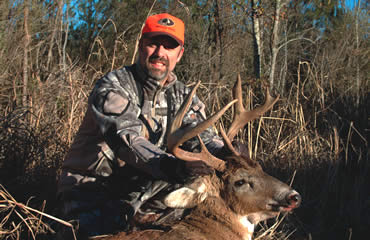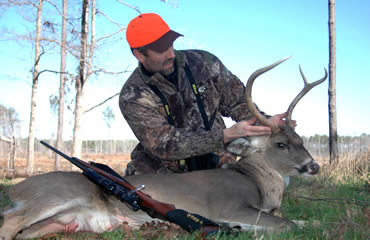Management bucks provide plenty of challenge at a fraction of the price.
Deer hunting can mean stress, most of which we thrust upon ourselves. In my case, the trouble began the moment I committed to an abbreviated, two-day hunt. A full day into it and with nothing to show, I was really starting to feel the pressure.
Light was fading fast on the second day when the buck for which I’d waited all afternoon finally showed. He was about 150 yards out and quartering away when he entered the food plot. Two things were immediately apparent. He wasn’t getting any closer, and he wouldn’t be around long. I had to react quickly. I hastily counted six points, settled the crosshairs on his chest and squeezed off a shot. In three bounds, the buck disappeared into the woods and it was over.
Then the doubt began. Did I make a good shot? I was using a borrowed T/C Pro Hunter, but felt fairly confident of my aim. But did I really see what I thought I saw? If not, there could be serious consequences.
You see, this was a management hunt. I’d been given very specific guidelines by my host and friend, K.C. Nelson, who manages the Tellom Timbers ranch in central Alabama. “You can shoot any mature bucks of seven points or less,” he told my hunting partner, C.J. Davis, and me. “Just make sure it’s mature and that it’s not a broke-off 8-pointer.” The broke-off part I figured I could handle. The mature part I wasn’t so sure about.
Being from New England, all Southern deer, even mature ones, look like yearlings to me. To make matters worse, we hunted solo, which meant there would be nobody to help me decide whether it was in fact a management buck or a youngster yet to realize his full antler potential. A mistake would create some serious stress for K.C. There was no room for error. Yet there I was, questioning what I’d just done.
It didn’t help that landowner Kern Mollet wanted to join in the recovery. “Ah well,” I thought, “If I messed up, he’s gonna find out sooner or later. It might as well be sooner.” First came finding the blood trail, assuming there was one. It turned out to be right where I thought it would be. Whew! The deer wasn’t far off, either. He’d traveled less than 100 yards. Fortunately, the mind works quicker than the eye. I breathed a heavy sigh of relief when I saw the buck was exactly as I thought I’d seen it the instant before I pulled the trigger: a perfect management buck.
 A Mature Perspective
A Mature Perspective
Trophy bucks rule the whitetail world, and like most hunters, I go afield hoping to bag one. But when it comes to big-racked bucks, I’m about as unlucky as any one person can be. Quite the opposite is true, however, when it comes to management bucks. In fact, my proficiency has led more than one guide to anoint me with the dubious title “Cull Buck Bob.” I’m proud to wear that moniker and happy to do all I can to retain the title.
Call it rationalization, but a mature buck is a mature buck, regardless of what adorns its head. They don’t know they’re not trophies. Management bucks are every bit as wary and just as challenging as their more well-endowed brethren. It takes just as much time, effort and attention to bag one. Granted, the thrill of victory is not quite as high, but the agony of defeat is far less severe than blowing a shot at a real monster.
They’re also a lot cheaper to hunt. If you’re not obsessed with antlers, you can get all the thrills of a guided trophy hunt for a fraction of the price.
There was a time when cull bucks and does were freebies. They were just extra mouths that the deer manager had to feed, and the bucks perpetuated poor antler characteristics. Ridding the herd of them was doing the manager a favor. That’s still true, but outfitters have realized people are willing to pay to hunt management deer. Now there’s a cost, but it’s still far less than a full-blown trophy hunt.
You also can do both. More outfitters are including management bucks as part of a trophy hunt for little or no additional cost.
 Great Opportunity
Great Opportunity
There are other ways a management hunt can reduce hunting-related stress. Let’s face it: Most of us don’t spend as much time in the woods as we could. Meanwhile, we put unreasonable expectations on ourselves to be successful. We spend hours fretting over that big buck. When he finally steps into the open, we’re so tense that we blow it. We haven’t had enough experience in the presence of shooter deer.
A management hunt will help instill more confidence in your shooting ability. If the landowner is serious about his management program, he’ll probably want you to take a few does as well. You end up with plenty of practice and venison in the freezer. So you can relax and wait out the rest of the hunt or the season for the deer of your choice. Under normal circumstances, you’re going to shoot the first good buck you see. On a management hunt, you can’t. As a result, you get to spend time watching mature bucks, studying their behavior and seeing how they interact with other deer. That alone is sometimes worth the price of admission.
You can also get some hands-on tutoring. In most cases, you’ll be accompanied by an experienced guide. Never one to pass up an opportunity, I always drill mine with questions. This helps me with judging the age and status of deer from various parts of the country. And we usually end up in a game of guess-the-score, which is also great practice for field-judging trophies.
Depending on what criteria are used, culling can also be part of a sound quality management program. Several years ago, I was hunting on a 14,000-acre Alabama property with an intensive QDM program. My goal was a trophy buck. I got what I considered a trophy the first afternoon. The moment I saw him, I knew I had to take him. His body was huge, his back was swayed and skin hung loosely under his chin. His antlers stood out, too. On the right side was a thick main beam and nothing more. The left side was similar, except for a small 4-inch tine toward the tip. This old warrior was obviously well past his prime and probably no longer involved in breeding. My guide later aged him at 9 and thanked me profusely for tagging him.
What IS a Management Buck?
There is no precise definition of a management or cull buck. The terms are often used interchangeably. It can vary from place to place, depending on management objectives, habitat quality and location. In general, however, it is a buck that a manager or biologist believes possesses inferior antler quality and/or will never achieve trophy status (the definition of which can also vary considerably). Examples include bucks with genetic antler deformities, bucks that are past their prime and show signs of declining antler quality, and mature bucks that exhibit inferior antler growth. Some management programs have more specific and stringent criteria. For example, some managers may recommend culling mature bucks with nine points or less.
This would include 8-pointers that could easily qualify as trophies under most management programs.
Editor’s Note: The Internet can be a good resource for info on aging deer on the hoof and by tooth wear. Search for “aging deer” and you’ll come up with dozens of articles. Texas Department of Wildlife and Parks and QDMA, among others, are reliable sources.
Read Recent Articles:
• A Buck's First Year: A whitetail’s first 12 months are fraught with peril, and some won’t survive.
• Duo Deer Hunt: Sometimes you can have the best of both hunting worlds.
This article was published in the November 2008 edition of Buckmasters Whitetail Magazine. Join today to have Buckmasters delivered to your home.